Bertha Mason's Role in Jane Eyre
VerifiedAdded on 2020/04/21
|5
|1421
|171
AI Summary
This assignment delves into the character of Bertha Mason from Charlotte Brontë's novel *Jane Eyre*. It analyzes her representation as a 'madwoman in the attic', exploring the social and psychological contexts that contribute to her characterization. The analysis examines the impact of Bertha on other characters, particularly Jane Eyre and Mr. Rochester, and considers how her story reflects Victorian marriage norms and gender roles.
Contribute Materials
Your contribution can guide someone’s learning journey. Share your
documents today.
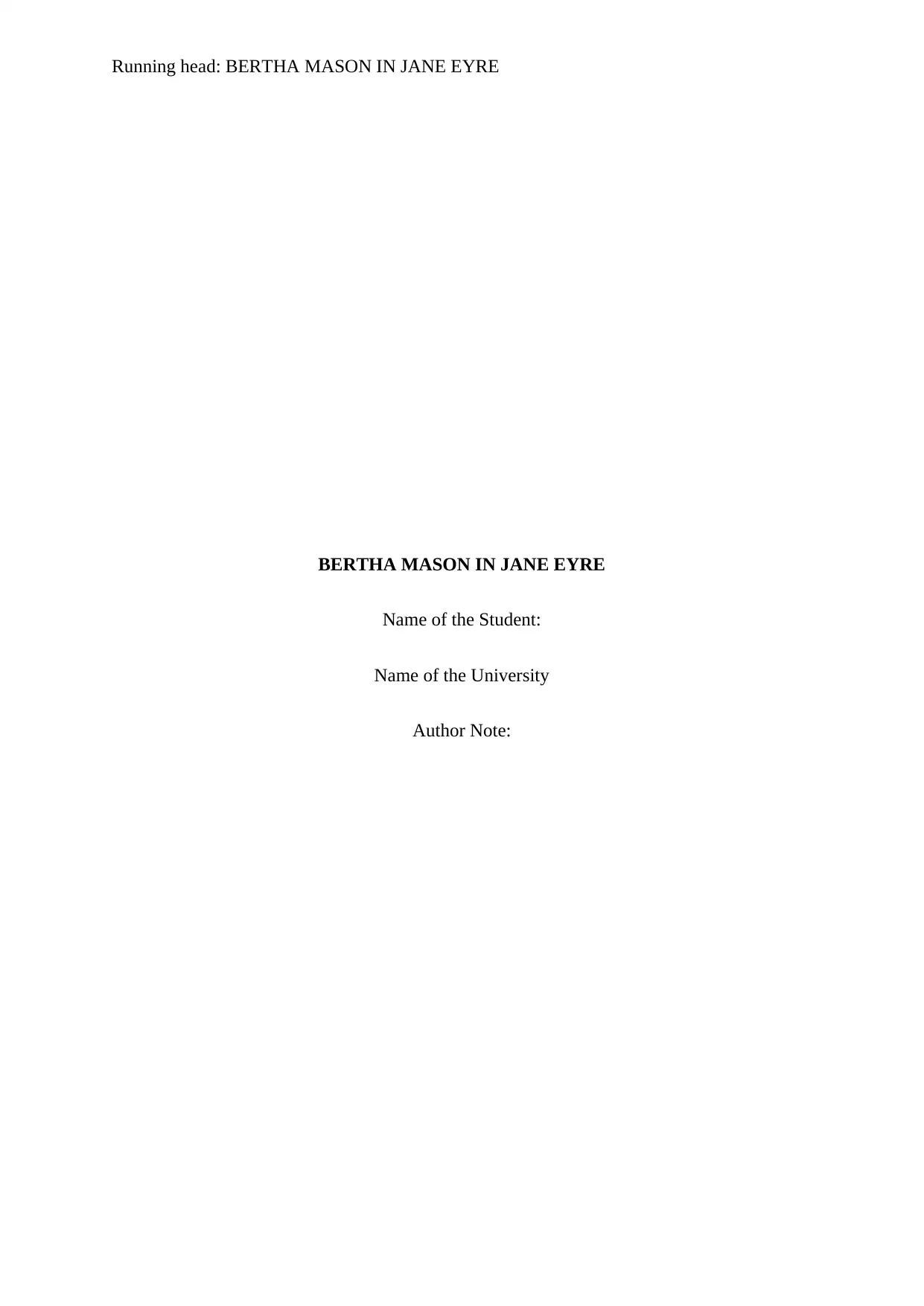
Running head: BERTHA MASON IN JANE EYRE
BERTHA MASON IN JANE EYRE
Name of the Student:
Name of the University
Author Note:
BERTHA MASON IN JANE EYRE
Name of the Student:
Name of the University
Author Note:
Secure Best Marks with AI Grader
Need help grading? Try our AI Grader for instant feedback on your assignments.
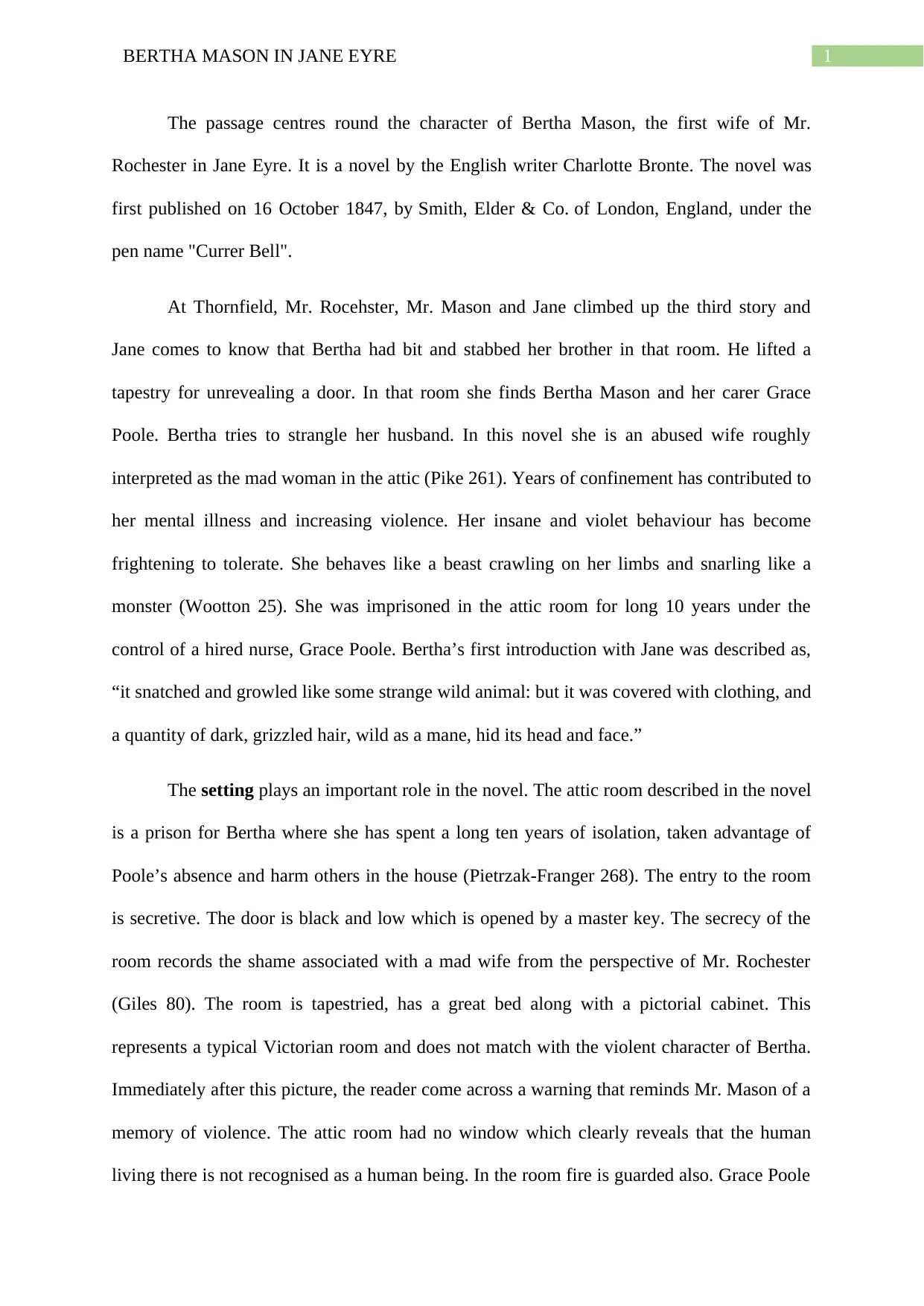
1BERTHA MASON IN JANE EYRE
The passage centres round the character of Bertha Mason, the first wife of Mr.
Rochester in Jane Eyre. It is a novel by the English writer Charlotte Bronte. The novel was
first published on 16 October 1847, by Smith, Elder & Co. of London, England, under the
pen name "Currer Bell".
At Thornfield, Mr. Rocehster, Mr. Mason and Jane climbed up the third story and
Jane comes to know that Bertha had bit and stabbed her brother in that room. He lifted a
tapestry for unrevealing a door. In that room she finds Bertha Mason and her carer Grace
Poole. Bertha tries to strangle her husband. In this novel she is an abused wife roughly
interpreted as the mad woman in the attic (Pike 261). Years of confinement has contributed to
her mental illness and increasing violence. Her insane and violet behaviour has become
frightening to tolerate. She behaves like a beast crawling on her limbs and snarling like a
monster (Wootton 25). She was imprisoned in the attic room for long 10 years under the
control of a hired nurse, Grace Poole. Bertha’s first introduction with Jane was described as,
“it snatched and growled like some strange wild animal: but it was covered with clothing, and
a quantity of dark, grizzled hair, wild as a mane, hid its head and face.”
The setting plays an important role in the novel. The attic room described in the novel
is a prison for Bertha where she has spent a long ten years of isolation, taken advantage of
Poole’s absence and harm others in the house (Pietrzak-Franger 268). The entry to the room
is secretive. The door is black and low which is opened by a master key. The secrecy of the
room records the shame associated with a mad wife from the perspective of Mr. Rochester
(Giles 80). The room is tapestried, has a great bed along with a pictorial cabinet. This
represents a typical Victorian room and does not match with the violent character of Bertha.
Immediately after this picture, the reader come across a warning that reminds Mr. Mason of a
memory of violence. The attic room had no window which clearly reveals that the human
living there is not recognised as a human being. In the room fire is guarded also. Grace Poole
The passage centres round the character of Bertha Mason, the first wife of Mr.
Rochester in Jane Eyre. It is a novel by the English writer Charlotte Bronte. The novel was
first published on 16 October 1847, by Smith, Elder & Co. of London, England, under the
pen name "Currer Bell".
At Thornfield, Mr. Rocehster, Mr. Mason and Jane climbed up the third story and
Jane comes to know that Bertha had bit and stabbed her brother in that room. He lifted a
tapestry for unrevealing a door. In that room she finds Bertha Mason and her carer Grace
Poole. Bertha tries to strangle her husband. In this novel she is an abused wife roughly
interpreted as the mad woman in the attic (Pike 261). Years of confinement has contributed to
her mental illness and increasing violence. Her insane and violet behaviour has become
frightening to tolerate. She behaves like a beast crawling on her limbs and snarling like a
monster (Wootton 25). She was imprisoned in the attic room for long 10 years under the
control of a hired nurse, Grace Poole. Bertha’s first introduction with Jane was described as,
“it snatched and growled like some strange wild animal: but it was covered with clothing, and
a quantity of dark, grizzled hair, wild as a mane, hid its head and face.”
The setting plays an important role in the novel. The attic room described in the novel
is a prison for Bertha where she has spent a long ten years of isolation, taken advantage of
Poole’s absence and harm others in the house (Pietrzak-Franger 268). The entry to the room
is secretive. The door is black and low which is opened by a master key. The secrecy of the
room records the shame associated with a mad wife from the perspective of Mr. Rochester
(Giles 80). The room is tapestried, has a great bed along with a pictorial cabinet. This
represents a typical Victorian room and does not match with the violent character of Bertha.
Immediately after this picture, the reader come across a warning that reminds Mr. Mason of a
memory of violence. The attic room had no window which clearly reveals that the human
living there is not recognised as a human being. In the room fire is guarded also. Grace Poole
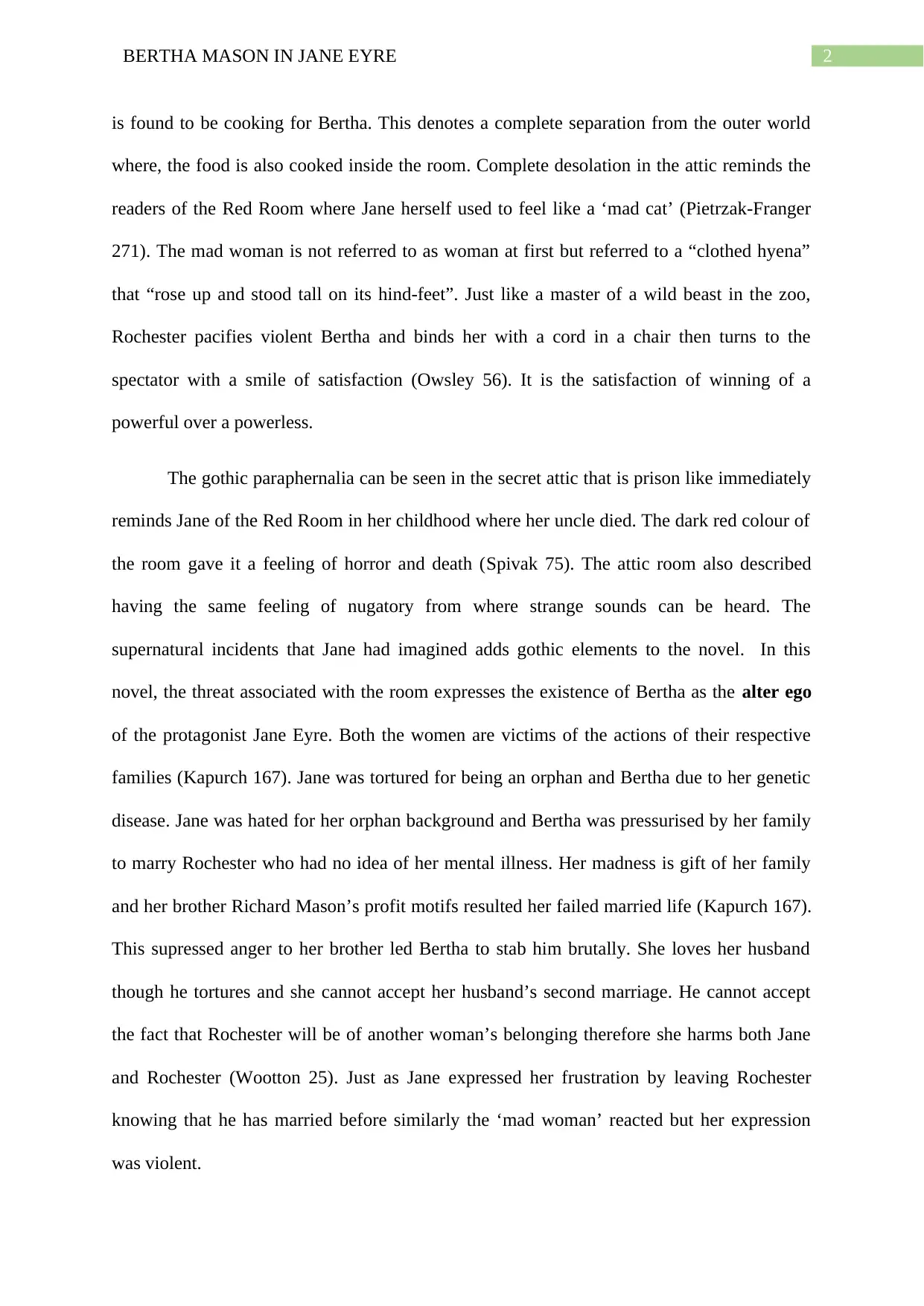
2BERTHA MASON IN JANE EYRE
is found to be cooking for Bertha. This denotes a complete separation from the outer world
where, the food is also cooked inside the room. Complete desolation in the attic reminds the
readers of the Red Room where Jane herself used to feel like a ‘mad cat’ (Pietrzak-Franger
271). The mad woman is not referred to as woman at first but referred to a “clothed hyena”
that “rose up and stood tall on its hind-feet”. Just like a master of a wild beast in the zoo,
Rochester pacifies violent Bertha and binds her with a cord in a chair then turns to the
spectator with a smile of satisfaction (Owsley 56). It is the satisfaction of winning of a
powerful over a powerless.
The gothic paraphernalia can be seen in the secret attic that is prison like immediately
reminds Jane of the Red Room in her childhood where her uncle died. The dark red colour of
the room gave it a feeling of horror and death (Spivak 75). The attic room also described
having the same feeling of nugatory from where strange sounds can be heard. The
supernatural incidents that Jane had imagined adds gothic elements to the novel. In this
novel, the threat associated with the room expresses the existence of Bertha as the alter ego
of the protagonist Jane Eyre. Both the women are victims of the actions of their respective
families (Kapurch 167). Jane was tortured for being an orphan and Bertha due to her genetic
disease. Jane was hated for her orphan background and Bertha was pressurised by her family
to marry Rochester who had no idea of her mental illness. Her madness is gift of her family
and her brother Richard Mason’s profit motifs resulted her failed married life (Kapurch 167).
This supressed anger to her brother led Bertha to stab him brutally. She loves her husband
though he tortures and she cannot accept her husband’s second marriage. He cannot accept
the fact that Rochester will be of another woman’s belonging therefore she harms both Jane
and Rochester (Wootton 25). Just as Jane expressed her frustration by leaving Rochester
knowing that he has married before similarly the ‘mad woman’ reacted but her expression
was violent.
is found to be cooking for Bertha. This denotes a complete separation from the outer world
where, the food is also cooked inside the room. Complete desolation in the attic reminds the
readers of the Red Room where Jane herself used to feel like a ‘mad cat’ (Pietrzak-Franger
271). The mad woman is not referred to as woman at first but referred to a “clothed hyena”
that “rose up and stood tall on its hind-feet”. Just like a master of a wild beast in the zoo,
Rochester pacifies violent Bertha and binds her with a cord in a chair then turns to the
spectator with a smile of satisfaction (Owsley 56). It is the satisfaction of winning of a
powerful over a powerless.
The gothic paraphernalia can be seen in the secret attic that is prison like immediately
reminds Jane of the Red Room in her childhood where her uncle died. The dark red colour of
the room gave it a feeling of horror and death (Spivak 75). The attic room also described
having the same feeling of nugatory from where strange sounds can be heard. The
supernatural incidents that Jane had imagined adds gothic elements to the novel. In this
novel, the threat associated with the room expresses the existence of Bertha as the alter ego
of the protagonist Jane Eyre. Both the women are victims of the actions of their respective
families (Kapurch 167). Jane was tortured for being an orphan and Bertha due to her genetic
disease. Jane was hated for her orphan background and Bertha was pressurised by her family
to marry Rochester who had no idea of her mental illness. Her madness is gift of her family
and her brother Richard Mason’s profit motifs resulted her failed married life (Kapurch 167).
This supressed anger to her brother led Bertha to stab him brutally. She loves her husband
though he tortures and she cannot accept her husband’s second marriage. He cannot accept
the fact that Rochester will be of another woman’s belonging therefore she harms both Jane
and Rochester (Wootton 25). Just as Jane expressed her frustration by leaving Rochester
knowing that he has married before similarly the ‘mad woman’ reacted but her expression
was violent.
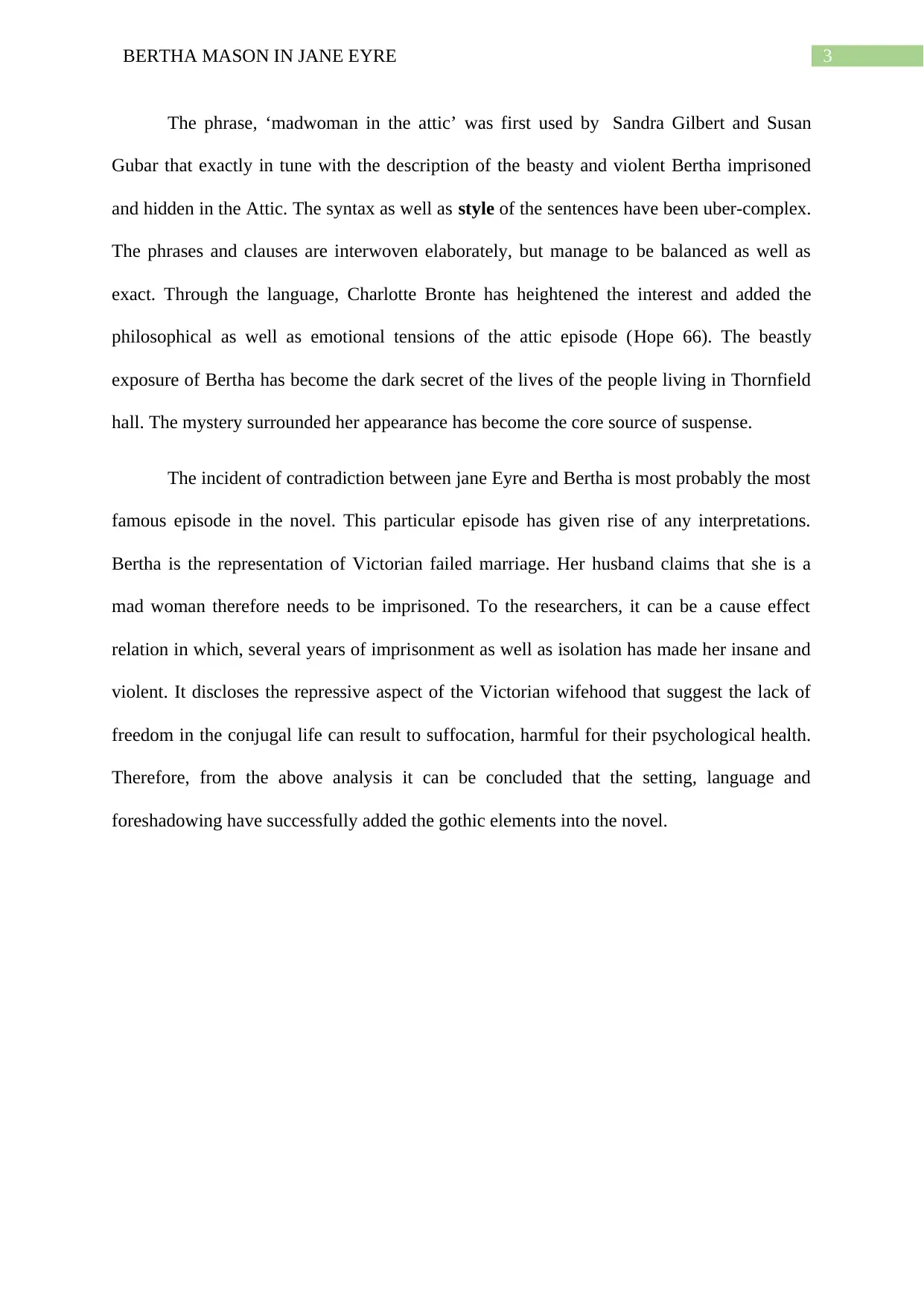
3BERTHA MASON IN JANE EYRE
The phrase, ‘madwoman in the attic’ was first used by Sandra Gilbert and Susan
Gubar that exactly in tune with the description of the beasty and violent Bertha imprisoned
and hidden in the Attic. The syntax as well as style of the sentences have been uber-complex.
The phrases and clauses are interwoven elaborately, but manage to be balanced as well as
exact. Through the language, Charlotte Bronte has heightened the interest and added the
philosophical as well as emotional tensions of the attic episode (Hope 66). The beastly
exposure of Bertha has become the dark secret of the lives of the people living in Thornfield
hall. The mystery surrounded her appearance has become the core source of suspense.
The incident of contradiction between jane Eyre and Bertha is most probably the most
famous episode in the novel. This particular episode has given rise of any interpretations.
Bertha is the representation of Victorian failed marriage. Her husband claims that she is a
mad woman therefore needs to be imprisoned. To the researchers, it can be a cause effect
relation in which, several years of imprisonment as well as isolation has made her insane and
violent. It discloses the repressive aspect of the Victorian wifehood that suggest the lack of
freedom in the conjugal life can result to suffocation, harmful for their psychological health.
Therefore, from the above analysis it can be concluded that the setting, language and
foreshadowing have successfully added the gothic elements into the novel.
The phrase, ‘madwoman in the attic’ was first used by Sandra Gilbert and Susan
Gubar that exactly in tune with the description of the beasty and violent Bertha imprisoned
and hidden in the Attic. The syntax as well as style of the sentences have been uber-complex.
The phrases and clauses are interwoven elaborately, but manage to be balanced as well as
exact. Through the language, Charlotte Bronte has heightened the interest and added the
philosophical as well as emotional tensions of the attic episode (Hope 66). The beastly
exposure of Bertha has become the dark secret of the lives of the people living in Thornfield
hall. The mystery surrounded her appearance has become the core source of suspense.
The incident of contradiction between jane Eyre and Bertha is most probably the most
famous episode in the novel. This particular episode has given rise of any interpretations.
Bertha is the representation of Victorian failed marriage. Her husband claims that she is a
mad woman therefore needs to be imprisoned. To the researchers, it can be a cause effect
relation in which, several years of imprisonment as well as isolation has made her insane and
violent. It discloses the repressive aspect of the Victorian wifehood that suggest the lack of
freedom in the conjugal life can result to suffocation, harmful for their psychological health.
Therefore, from the above analysis it can be concluded that the setting, language and
foreshadowing have successfully added the gothic elements into the novel.
Secure Best Marks with AI Grader
Need help grading? Try our AI Grader for instant feedback on your assignments.
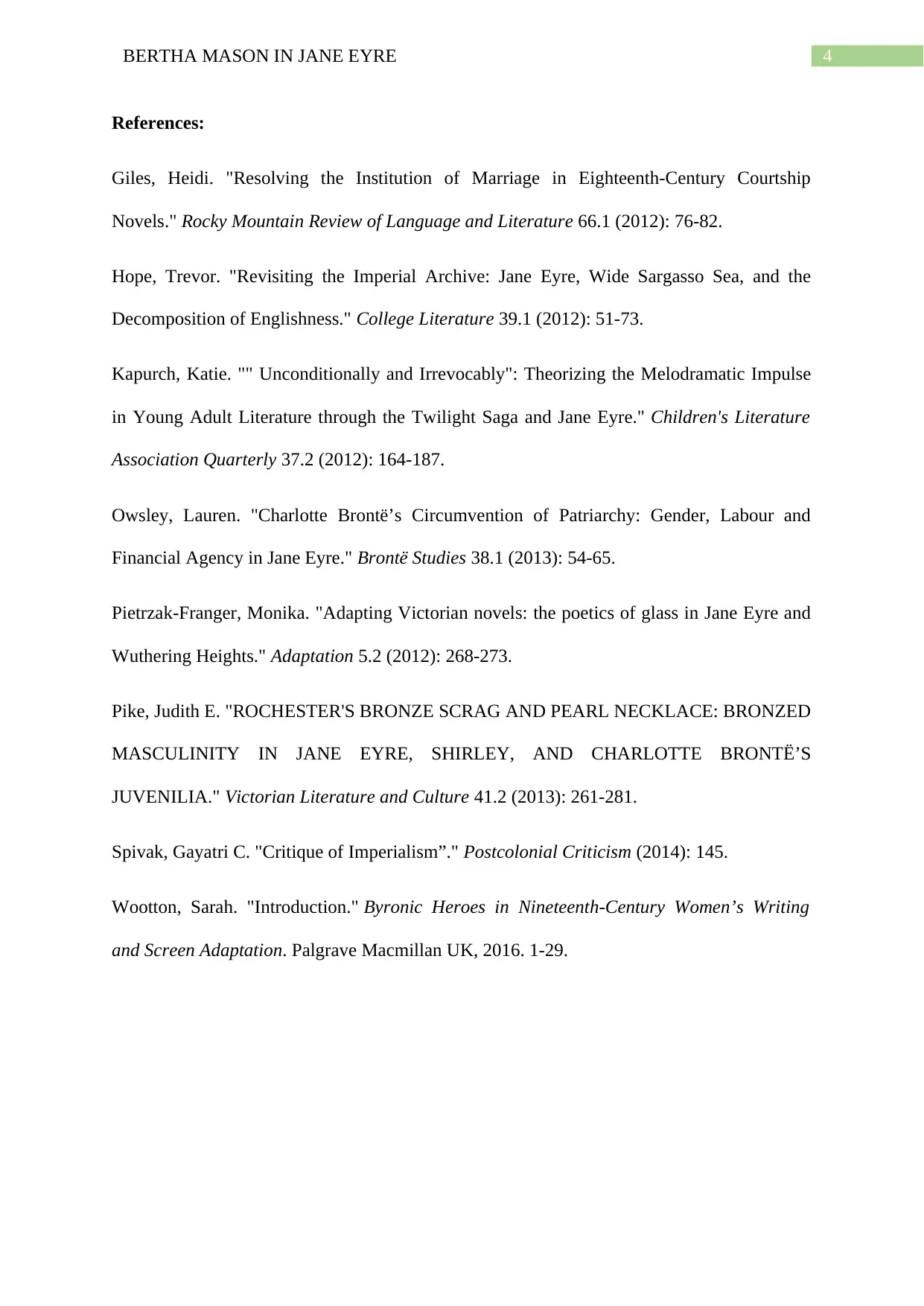
4BERTHA MASON IN JANE EYRE
References:
Giles, Heidi. "Resolving the Institution of Marriage in Eighteenth-Century Courtship
Novels." Rocky Mountain Review of Language and Literature 66.1 (2012): 76-82.
Hope, Trevor. "Revisiting the Imperial Archive: Jane Eyre, Wide Sargasso Sea, and the
Decomposition of Englishness." College Literature 39.1 (2012): 51-73.
Kapurch, Katie. "" Unconditionally and Irrevocably": Theorizing the Melodramatic Impulse
in Young Adult Literature through the Twilight Saga and Jane Eyre." Children's Literature
Association Quarterly 37.2 (2012): 164-187.
Owsley, Lauren. "Charlotte Brontë’s Circumvention of Patriarchy: Gender, Labour and
Financial Agency in Jane Eyre." Brontë Studies 38.1 (2013): 54-65.
Pietrzak-Franger, Monika. "Adapting Victorian novels: the poetics of glass in Jane Eyre and
Wuthering Heights." Adaptation 5.2 (2012): 268-273.
Pike, Judith E. "ROCHESTER'S BRONZE SCRAG AND PEARL NECKLACE: BRONZED
MASCULINITY IN JANE EYRE, SHIRLEY, AND CHARLOTTE BRONTË’S
JUVENILIA." Victorian Literature and Culture 41.2 (2013): 261-281.
Spivak, Gayatri C. "Critique of Imperialism”." Postcolonial Criticism (2014): 145.
Wootton, Sarah. "Introduction." Byronic Heroes in Nineteenth-Century Women’s Writing
and Screen Adaptation. Palgrave Macmillan UK, 2016. 1-29.
References:
Giles, Heidi. "Resolving the Institution of Marriage in Eighteenth-Century Courtship
Novels." Rocky Mountain Review of Language and Literature 66.1 (2012): 76-82.
Hope, Trevor. "Revisiting the Imperial Archive: Jane Eyre, Wide Sargasso Sea, and the
Decomposition of Englishness." College Literature 39.1 (2012): 51-73.
Kapurch, Katie. "" Unconditionally and Irrevocably": Theorizing the Melodramatic Impulse
in Young Adult Literature through the Twilight Saga and Jane Eyre." Children's Literature
Association Quarterly 37.2 (2012): 164-187.
Owsley, Lauren. "Charlotte Brontë’s Circumvention of Patriarchy: Gender, Labour and
Financial Agency in Jane Eyre." Brontë Studies 38.1 (2013): 54-65.
Pietrzak-Franger, Monika. "Adapting Victorian novels: the poetics of glass in Jane Eyre and
Wuthering Heights." Adaptation 5.2 (2012): 268-273.
Pike, Judith E. "ROCHESTER'S BRONZE SCRAG AND PEARL NECKLACE: BRONZED
MASCULINITY IN JANE EYRE, SHIRLEY, AND CHARLOTTE BRONTË’S
JUVENILIA." Victorian Literature and Culture 41.2 (2013): 261-281.
Spivak, Gayatri C. "Critique of Imperialism”." Postcolonial Criticism (2014): 145.
Wootton, Sarah. "Introduction." Byronic Heroes in Nineteenth-Century Women’s Writing
and Screen Adaptation. Palgrave Macmillan UK, 2016. 1-29.
1 out of 5
Your All-in-One AI-Powered Toolkit for Academic Success.
+13062052269
info@desklib.com
Available 24*7 on WhatsApp / Email
![[object Object]](/_next/static/media/star-bottom.7253800d.svg)
Unlock your academic potential
© 2024 | Zucol Services PVT LTD | All rights reserved.
